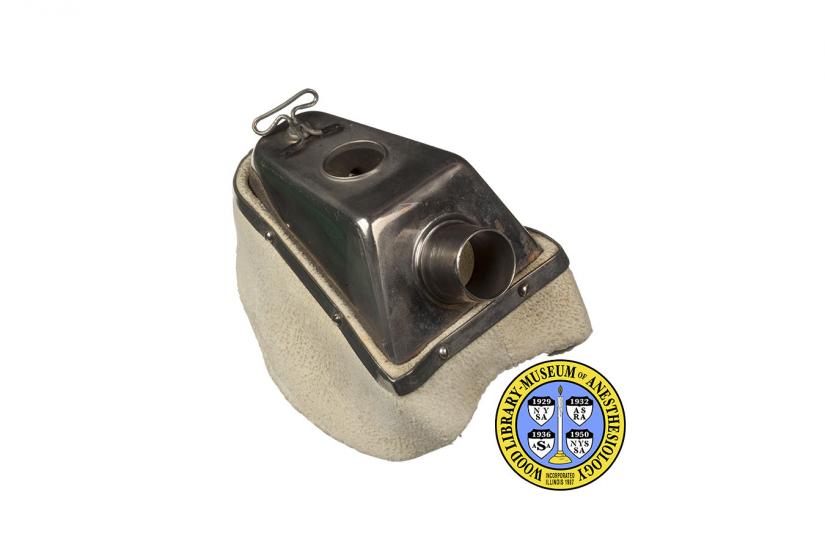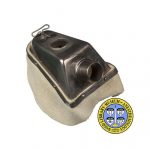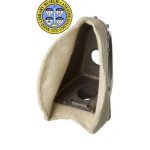Snow Mask
Dr. John Snow (1813-1858), was the first physician to specialize in anesthesia. He administered chloroform to England’s Queen Victoria for the births of Prince Leopold and Princess Beatrice, the last two of her nine children. From 1847 through 1849, he introduced his designs for several ether and chloroform inhalers. Snow’s mask was a modification of an earlier device that was held in place by straps. It was the first hand-held mask to cover the patient’s nose and mouth, giving the anesthesiologist more control over administration, yet leaving one of his hands free. The mask was made of sheet metal, with a pliable lead rim, and covered with cloth or leather. Snow’s design included an inspiration valve that shut when the patient stopped inhaling, and an expiration valve that could be swiveled aside to admit external air. Snow did not patent his mask, and many modifications of it were made. The example shown here appears to be a faithful replica.
Catalog Record: Snow Mask
Access Key: akvp
Accession No.: 1995-03-31-1 DN
Title: [Snow mask.]
Author: Snow, John, 1813-1858.
Title variation: Alt Title
Title: Snow face-piece.
Title variation: Alt Title
Title: Snow’s mask.
Publisher: [Place of production not identified] : [producer not identified], [between 1950 and 1990].
Physical Descript: 1 oronasal mask : metals, suede ; 11 x 8 x 7.5 cm.
Subject: Snow, John, 1813-1858.
Subject: Masks, Anesthesia.
Subject: Ether, Sulphuric – administration & dosage.
Note Type: General
Notes: The date range for the possible year of production is a very rough estimate
based on the condition and type of construction. This is assumed to be a
replica. The date range could change if new documentation indicates that it
should be corrected.
Note Type: General
Notes: The title is based on the WLM common name for the item. The alternate title,
“Snow Face-Piece,” is based on the words used by Dr. Snow to describe the
object in the publication in which the mask was first illustrated (It is also
described as a face-piece in St. George’s Hospital report on page 35 of the
July 10, 1847 issue of The Lancet. Also, he modified the mask from one
designed by Dr. Sibson. Dr. Snow refers to Dr. Sibson’s mask as a
“face-piece” on page 552 in the May 29, 1847 issue of The Lancet.
Note Type: Citation
Notes: Connor H, Zuck D. A very rare ether vaporizer designed by John Snow. Hist
Anaesth Soc Proc. May, 2009;41:105-122. https://www.histansoc.org.
uk/proceedings.html. Accessed September 28, 2014.
Note Type: Citation
Notes: Ether & chloroform chronology: 1846-1848. The John Snow Archive and Research
Companion website. https://johnsnow.matrix.msu.edu/chronether.php. Accessed
May 2, 2014.
Note Type: Citation
Notes: Hospital reports: St. George’s Hospital. Lancet. July 10, 1847;2(2):35.
https://books.google.
com/books?id=vBdAAAAAcAAJ&printsec=frontcover#v=onepage&q&f=false. Accessed
September 28, 2014. [“The vapour of ether was administered in all these cases
by Dr. Snow. In the last two operations he used a face-piece, which he has
altered from that described in the last report (the last report was the
Sibson mask), and introduced two swing valves into it, to supersede the
spherical valves he had previously used.” The last two cases described were
performed on June 10 and June 17, 1847.]
Note Type: Citation
Notes: Maltby JR. Francis Sibson, 1814-1876. Pioneer and prophet in anaesthesia.
Anaesthesia. 1977 Jan;32(1):53-62.
Note Type: Citation
Notes: Ord WM. A short account of the life and writings of Dr. Sibson. In: Ord WM,
ed. Collected Works of Francis Sibson. Vol 1. London: MacMillan and Co.
;1881:xix-xliii. https://books.google.
com/books?id=Vxi6AAAAIAAJ&printsec=frontcover#v=onepage&q&f=false. Accessed
July 24, 2014.
Note Type: Citation
Notes: Ramsay MAE. John Snow, MD: anaesthetist to the Queen of England and pioneer
epidemiologist. Proc Bayl Univ Med Cent. 2006;19(1):24–28. https://www.ncbi.
nlm.nih.gov/pmc/articles/PMC1325279/pdf/bumc0019-0024.pdf. Accessed July,
2014.
Note Type: Citation
Notes: Reviews: On the Inhalation of the Vapour of Ether in Surgical Operations.
Lancet. October 16, 1847;2:410. https://books.google.
com/books?id=2wECAAAAYAAJ&dq=editions:SugUsl8D8dAC&source=gbs_navlinks_s.
Accessed May 2, 2014.
Note Type: Citation
Notes: Sibson F. On the treatment of facial neuralgia by the inhalation of ether,
and on a new inhaler. London Med Gazette. February 26, 1847;39: 353-364.
https://books.google.
com/books?id=LBajXaoQ53wC&printsec=frontcover#v=onepage&q&f=false. Accessed
September 28, 2014. [A modification of Dr. John Snow’s inhaler/vaporizer is
pictured on page 362, and an illustration of Dr. Sibson’s nose and
mouth-piece (face-piece) is pictured on page 363.]
Note Type: Citation
Notes: Sibson F. Remarks on the action of narcotic poisons, the effects of
chloroform, and the sates of insensibility produced by it-treatment of cases
of poisoning by the vapour. London Med Gazette. February 11, 1848;6:267-271.
https://books.google.
com/books?id=bPGzSCkdEk0C&printsec=frontcover#v=onepage&q&f=false. Accessed
May 2, 2014.
Note Type: Citation
Notes: Snow J. Chloroform. In: Richardson BW, ed. On Chloroform and Other
Anaesthetics: Their Action and Administration. London: John Churchill; 1858:
81-82. https://books.google.
com/books?id=yOI8AAAAcAAJ&printsec=frontcover#v=onepage&q&f=false. Accessed
July, 25, 2014.
Note Type: Citation
Notes: Snow J. On the inhalation of chloroform and ether with description of an
apparatus. Lancet. February 12, 1848;1:177-180. https://books.google.
com/books?id=DP8BAAAAYAAJ&printsec=frontcover#v=onepage&q&f=false. Accessed
May 2, 2014. [Describes his modification of Dr. Sibson’s nose and mouth piece
and that he has been using it since June 1847 (page 179).]
Note Type: Citation
Notes: Snow J. On the inhalation of the vapour of ether in surgical operations.
Lancet. May 29, 1847;1(22):551-554. https://books.google.
com/books?id=nhdAAAAAcAAJ&printsec=frontcover#v=onepage&q&f=false. Accessed
May 2, 2014.
Note Type: Citation
Notes: Snow J. On the Inhalation of the Vapour of Ether in Surgical Operations:
Containing a Description of the Various Stages of Etherization. London: John
Churchill; 1847:16-17. https://books.google.
com/books?id=JCQSAAAAYAAJ&printsec=frontcover#v=onepage&q&f=false. Accessed
September 28, 2014. [This monograph may have been published in September or
October of 1847. It contains illustrations and descriptions of the face-piece.] ]
Note Type: Citation
Notes: Snow J. Sulphuric ether, or ether. In: Richardson BW, ed. On Chloroform and
Other Anaesthetics: Their Action and Administration. London: John Churchill;
1858: 347-348. https://books.google.
com/books?id=yOI8AAAAcAAJ&printsec=frontcover#v=onepage&q&f=false. Accessed
July, 25, 2014.
Note Type: Physical Description
Notes: One oronasal mask for the administration of anesthesia; It appears to be a
replica of a mask designed by John Snow; The measurements and description are
based on a patient’s perspective (facing the inside of the mask); The main
body of the mask is triangular is shape and made of metal (steel?), which is
polished on the external side; On the most distal side of the mask is a 1.8
cm round opening for a valve; A rotating, ‘pin’, intended to hold the
expiratory valve, is affixed to the mask just above the opening for the
valve; Rubber valves did not accompany this mask on acquisition; A pliable
metal covered is white suede lines the entire rim of the most proximal endge
of the main body of the mask; The suede is a little soiled and shows soem
signs of wear around the seams; There are no markings by the maker or by
previous owners.
Note Type: Reproduction
Notes: Photographed by Mr. Steve Donisch, September 16, 2013.
Note Type: Acquisition
Notes: Donated to the WLM by Mrs. Roderick Calverley.
Note Type: Historical
Notes: This mask was designed by English physician Dr. John Snow (1813-1858) in 1847
Dr. Snow was a pioneer of two medical specialties: epidemiology (the study
of the frequency, distribution, and causes of disease in human populations)
and anesthesiology. He began life as the intelligent and driven son of a coal
miner, and became a surgeon’s apprentice at the age of 14. While studying
medicine at the Hunterian School of Medicine he discovered and published
evidence that the use of arsenic to preserve cadavers was causing students to
become ill. This led to changes in how bodies were preserved for anatomical
study, and is an example of his early epidemiological work. After earning the
title of surgeon in 1838, and doctor in 1844, he quickly became well regarded
by his colleagues.
On December 19, 1846, ether was first administered as an anesthetic in
England. Dr. Snow witnessed a demonstration nine days later. A month later he
was explaining to colleagues the scientific principles of ether vaporization,
including the important relationship between the temperature of the
anesthetic and the concentration of vapor. With this understanding, he began
to develop an inhaler that would allow anaesthetists to maintain and control
the vapor concentration.
During 1847, Dr. Snow modified and improved his inhaler a number of times.
His early inhalers were designed not with masks but with mouth-pieces
connected to the inhaler by tubing. He soon discovered that if patients
breathed through their nostrils they inhaled little to no ether through the
mouth piece.
In May of 1847, Dr. Snow described using a “face-piece” that covered both the
nose and the mouth. It was designed by the English surgeon Francis Sibson
(1814-1876) for use with his modification of one of Snow’s inhalers. Dr. Snow
modified Sibson’s mask and used it to administer ether as early as June 10,
1847. An illustration of Snow’s modified Sibson mask was included in Dr.
Snow’s monograph, “The Inhalation of the Vapour of Ether in Surgical
Operations: Containing a Description of the Various Stages of Etherization,”
published in September or October of 1847. Dr. Snow also used this mask to
administer chloroform after its introduction later in the year.
It did not take long for Dr. Snow’s services as an anaesthetist to come into
high demand. Perhaps there could be no better evidence of the high regard for
Dr. Snow’s expertise than Queen Victoria having asked him to administer
chloroform for the delivery of her eighth child, Prince Leopold, in 1853.
Note Type: Publication
Notes: Maltby JR. Francis Sibson, 1814-1876: pioneer and prophet in anaesthesia.
Anaesthesia. 1977;32(1):53-62.
Note Type: Exhibition
Notes: Displayed in the WLM Park Ridge gallery from 2000-2006; Selected for the WLM
website.



